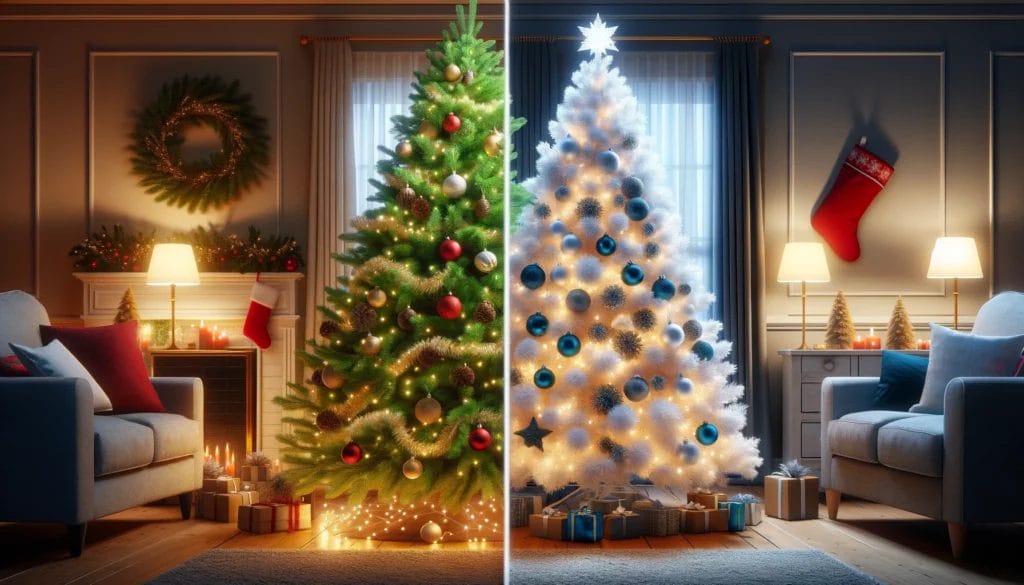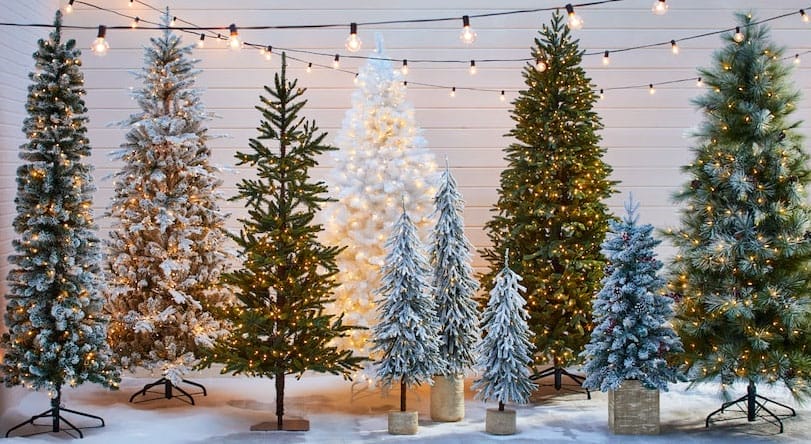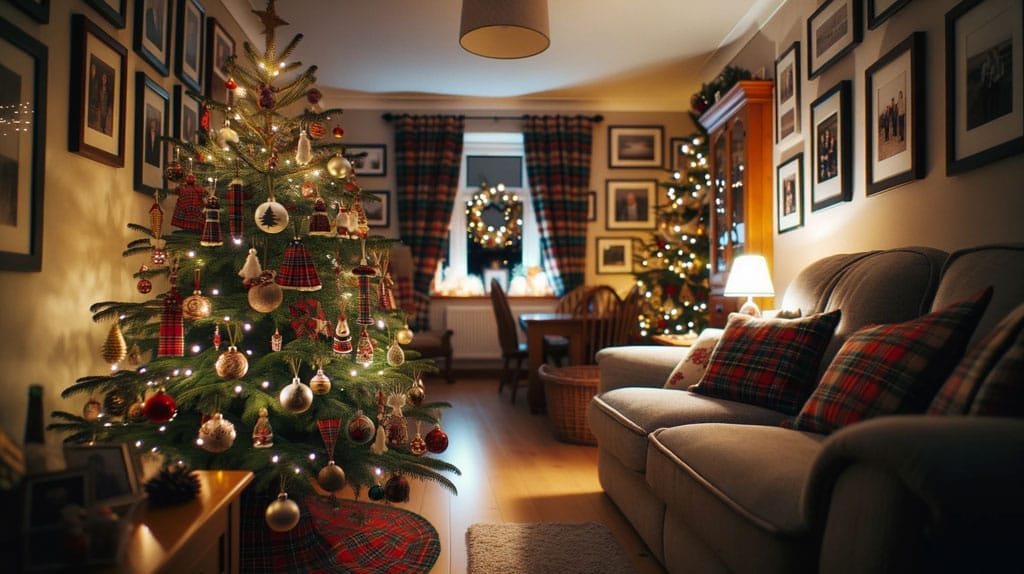Explore Benefits of Artificial vs Real Trees Today!

As the holiday season approaches, one of the most significant decisions homeowners face is choosing between artificial and real trees. Both options have their pros and cons, and it can be challenging to decide which one is right for you. In this article, we will explore the various benefits of artificial trees compared to real trees.
Key Takeaways:
- Artificial trees have a longer lifespan and require minimal maintenance compared to real trees.
- If you enjoy the authentic scent of real trees, you can recreate this atmosphere using scented candles or essential oils.
- Artificial trees can be a cost-effective and convenient option due to their reusability and easy setup.
- Allergies and fire safety are important factors to consider when choosing between artificial and real trees. Artificial trees can be a safer option.
- When considering sustainability, recycling and proper disposal of artificial trees are important factors to take into account.
Comparing Artificial and Real Christmas Trees
| Feature | Real Christmas Tree | Artificial Christmas Tree |
|---|---|---|
| Scent | Natural pine smell | No scent (unless added) |
| Cost | Annual purchase | One-time investment |
| Care | Requires water | No maintenance |
| Safety | Fire risk when dry | Usually fire-retardant |
| Storage | No storage needed | Requires storage space |
| Setup | Can be cumbersome | Easy and quick |
| Life | One season | Multiple seasons |
As the holiday season approaches, a sparkling Christmas tree becomes the centerpiece of many homes, embodying the spirit of the season. The debate between choosing a real Christmas tree or an artificial one is as old as the tradition of the tree itself. This article addresses the heart of this festive dilemma, laying out the pros and cons of each option in a way that’s easy to understand.
Real Christmas trees come with the irresistible scent of pine and an authentic touch that’s hard to replicate. But they require care and can leave a trail of needles in their wake. On the other hand, artificial trees offer unmatched convenience and a one-time purchase appeal, making them a favorite for those who dread the post-holiday clean-up.
To help you compare, we’ll use simple tables to highlight key points, like cost comparison and maintenance needs, making it easier for you to decide which tree might be the right fit for your home this year. By the end of this article, you’ll have a clearer picture of what each choice offers, and you might just find yourself ready to make the perfect pick for a merry and bright holiday.
Cost Comparison
Prices can vary greatly depending on the quality, type, and where the tree is purchased. Artificial trees can be a larger one-time purchase, but they can be used for many years, potentially leading to cost savings over time. Real trees must be purchased annually, but they are often less expensive for a single year’s use.
The comparison below is based on the the average cost of trees purchased in the USA:
| Tree Size | Real Tree Cost (USD) | Artificial Tree Cost (USD) | Notes |
|---|---|---|---|
| Small | $25 – $50 | $60 – $120 | Small: Around 4-6 feet |
| Medium | $35 – $75 | $100 – $250 | Medium: Around 6-7 feet |
| Large | $50 – $100 | $150 – $500+ | Large: Over 7 feet, can be significantly more based on quality and features |
Section 1: The Case for Real Christmas Trees
Real Christmas trees have been at the heart of this tradition for centuries, bringing a piece of nature into our homes for the holiday season. But why choose a real tree over an artificial one? Let’s explore the benefits and some of the drawbacks you might encounter with a real Christmas tree.

Sensory Appeal
- The Authentic Scent and Feel – Real Christmas trees are known for their wonderful, natural scent, which many people associate with the joy and nostalgia of the season. Running your fingers through the needles, you feel a connection to nature and the holidays that a synthetic tree simply can’t replicate.
- The Unique Character of Each Tree – No two real Christmas trees are exactly alike. Each one has its own shape, size, and branch structure, which means you get a unique tree every year. This variety adds a special personal touch to your holiday décor.
Environmental Considerations
- Biodegradable and Sustainable – Real trees are a renewable resource. They are grown on farms just like any other crop, which means more are planted each year than are cut down. After the holidays, real trees can be recycled or composted, returning to nature without leaving behind waste.
- Supports Local Agriculture and Economy – Buying a real tree often means you’re supporting local tree farmers and contributing to the local economy. This table shows how your choice impacts more than just your living room:
| Benefit | Description |
|---|---|
| Sustainable Farming | Tree farms preserve green space and produce oxygen. |
| Economic Support | Money spent on real trees supports local businesses. |
| Agricultural Advancement | Tree farming advances agricultural techniques. |
Tradition and Experience
- The Family Ritual of Choosing a Tree – For many, the act of choosing a real Christmas tree is a cherished annual tradition. Families often head to a local tree farm together, searching for the perfect tree to take home. This experience can create lifelong memories.
- Connection to Christmas Traditions – Real trees keep us connected to the long-standing traditions of Christmas. The practice of bringing a tree into the home dates back hundreds of years, and by choosing a real tree, you are participating in this historic ritual.
Drawbacks
- Regular Maintenance – Real trees require some work. They need to be watered regularly to stay fresh throughout the season, and they can shed needles, which requires cleanup.
- Potential Fire Hazard – If a real tree becomes dry, it can become a fire hazard. It’s important to keep the tree well-watered and away from heat sources.
- Yearly Expense and Disposal Concerns – Each year, you will need to purchase a new tree, which can add up over time. After Christmas, you also have to figure out how to properly dispose of the tree, which may be a hassle for some.
Real Christmas trees offer sensory delights, environmental benefits, and a connection to tradition that is hard to match. However, they do require more care and can be less convenient than their artificial counterparts. As we move to explore artificial Christmas trees in the next section, consider how the points above align with your holiday values and lifestyle.
Section 2: The Case for Artificial Christmas Trees
Artificial Christmas trees have surged in popularity, becoming a staple in many households during the holiday season. Their appeal lies in the blend of convenience, cost-effectiveness, and safety they offer, alongside a myriad of style options that cater to diverse tastes and space constraints.

With technological advancements, these trees have become more realistic and easier to set up, further cementing their place as a festive favorite for those seeking a hassle-free, long-lasting alternative to real trees.
Convenience and Ease
- No-Mess, No-Fuss – Unlike real trees, artificial ones offer a significant advantage when it comes to convenience. With no needles to sweep up and no daily watering needed, they provide a no-mess solution to holiday decorating.
This is especially appealing to those who have busy schedules or prefer not to deal with the upkeep required by a real tree. The time saved on maintenance can be redirected towards relaxing and participating in festive activities with family and friends.
- Easy Setup and Take-Down – The design of artificial trees caters to ease of use. They typically come in sections with clear, user-friendly instructions, making the setup process straightforward. The branches are often pre-attached to the center pole, unfolding with ease, and they sometimes even include pre-strung lights.
Dismantling the tree after the holidays is just as simple. The tree can be quickly taken apart and stowed away in compact storage, without the hassle of disposing of a large, unwieldy organic tree.
- Longevity – Opting for an artificial tree is a choice that pays dividends over time. These trees are built to last, with many families using the same tree for a decade or more, ensuring that the investment is spread over several seasons.
While the initial cost of an artificial tree may be higher than buying a real one, the long-term savings are clear. There’s no need to purchase a new tree each year, and the avoidance of disposal fees or cleanup efforts further adds to the economic appeal of artificial trees.
Cost and Value
- Upfront Investment Pays Off – The initial price tag of an artificial Christmas tree might give you pause as it often exceeds the cost of its real counterpart. However, this expense is not recurring; it’s a one-time investment.
An artificial tree, with proper care and storage, can last for many years, sometimes even decades. This means that over the lifespan of the artificial tree, you could save a significant amount of money by avoiding the annual expense of purchasing a real tree each season.
- No Annual Expenses – Say goodbye to the yearly cost of buying a real tree. An artificial tree eliminates the need for an annual tree-purchasing budget.
Environmental Impact
- Minimized Waste Contribution – Artificial Christmas trees offer a sustainable alternative by diminishing the yearly waste associated with the holiday season. Unlike real trees that end up in landfills after their brief stint of festive cheer, a well-maintained artificial tree can adorn homes for numerous years.
- Reduced Carbon Footprint – Real trees necessitate a cyclical process of planting, growing, cutting, and transporting, all of which contribute to carbon output annually. An artificial tree, once manufactured, eliminates the need for this repetitive cycle, curtailing the carbon footprint associated with the festive tradition of tree decorating.
By investing in a quality artificial tree that can be used for a decade or longer, you contribute to a reduction in the emissions generated by the annual turnover of real trees.
Consistent Aesthetics
- Picture-Perfect Shape – One of the standout qualities of artificial Christmas trees is their flawless form. Engineered for perfection, these trees boast a symmetry that natural trees often can’t match, ensuring that your festive displays maintain a magazine-worthy look each season.
- Wider Range of Choices – The diversity of artificial trees is impressive. Whether you’re seeking a compact tree for a snug apartment or a grand one to be the centerpiece of a spacious room, there’s an artificial tree that fits the bill.
Beyond size, they also come in a palette of colors—from traditional greens to snowy whites and even unconventional pinks or blues. This vast selection makes it simple to coordinate with your existing holiday decor or start a new theme altogether.
Health and Safety Considerations for Artificial Christmas Trees
For individuals who suffer from seasonal allergies, artificial Christmas trees present a significant advantage. Unlike their natural counterparts, these synthetic trees do not harbor pollen or mold, common allergens that can turn a festive season into a time of discomfort.
Essential Christmas Tree Safety Tips for a Festive Season
As the festive season approaches, twinkling lights and beautifully adorned Christmas trees become the centerpiece in homes. But amidst the merriment, it’s crucial to prioritize safety. Every year, holiday decorations contribute to accidents and fires. To ensure that…
This hypoallergenic quality makes artificial trees a preferred option for allergy sufferers, ensuring that the holiday spirit is not dampened by allergic reactions.
In terms of safety, artificial Christmas trees offer an additional layer of reassurance. Crafted from materials that are typically treated to be flame-retardant, these trees reduce the risk of fire, a particularly important consideration during the holiday season when the use of lights and decorations can increase the potential for accidents.
While all electric decorations carry some risk and require careful handling and monitoring, the flame-resistant nature of artificial trees can provide an extra measure of security, allowing families to celebrate with greater peace of mind.
Drawbacks
- Lack of Natural Scent – One of the most notable drawbacks of artificial trees is the absence of the fresh pine scent that is quintessential to the Christmas experience. This aroma often evokes festive memories and is a beloved aspect of the holiday season for many people.
While some may use scented candles or sprays to mimic this fragrance, it’s not quite the same as the authentic smell that emanates from a real tree.
- Environmental Concerns – Artificial trees, made primarily from plastic materials and metal, present certain environmental concerns. Although they offer the convenience of multiple years of use, they are not biodegradable. At the end of their life cycle, these trees end up in landfills where they may take centuries to break down, if at all.
For those who are eco-conscious, this can be a significant downside, as the production and disposal of artificial trees contribute to plastic pollution and resource depletion.
- Storage – Another practical consideration is the storage of artificial trees. Unlike real trees that are recycled or composted after the holidays, artificial trees need to be packed away and stored. This can be a considerable inconvenience, especially for those living in smaller spaces or apartments.
Storing a large, bulky item for eleven months of the year requires dedicated space that not everyone may have, making it a less desirable option for those with limited storage capabilities.

Comparing Cost and Convenience
| Artificial Tree | Real Tree | |
|---|---|---|
| Initial Purchase Price | $100-$500 | $50-$200 |
| Reusability | Can be reused year after year | Must be repurchased annually |
| Maintenance | Minimal maintenance required | Regular watering and care required |
| Transportation | Easy to transport and set up | Requires transportation and setup |
| Cleanup | No needles or sap to clean up | Needles and sap can create a mess |
As shown in the table above, artificial trees offer a range of cost and convenience benefits compared to real trees. Ultimately, the choice between an artificial or a real tree comes down to your personal preference and lifestyle needs. Consider the factors discussed in this article, and you’ll be sure to make an informed decision that meets your needs and budget.
Making an Informed Decision
The final choice boils down to what matters most to you. Do you cherish the authentic experience of a real tree, with its earthy aroma and the joy of selecting the perfect one each year? Or does the ease of an artificial tree, ready to dazzle without the hassle, light up your holiday spirit?
| Real Christmas Trees | Artificial Christmas Trees |
|---|---|
| Fresh pine scent | No need to water |
| Unique shape and size each year | Use it year after year |
| Biodegradable | No needle cleanup |
| Can be a fire hazard | Made of non-biodegradable materials |
| Requires annual purchase | Storage space needed |
Remember, it’s not just about the sparkle of the lights or the shimmer of the tinsel. It’s about the environment, your health, and your wallet too. Real trees might give you that classic Christmas vibe but think about the yearly costs and the needles you’ll find in your socks in July! Artificial trees can be a game-changer if you’re after something that lasts and is easy to manage, but don’t forget they come from factories and eventually end up in landfills.
Artificial trees offer advantages such as longevity, convenience, and cost-effectiveness. They also eliminate the potential allergy risks and fire hazards associated with real trees. However, the materials used in artificial trees and their impact on the environment should also be taken into account.
Whatever tree you choose, make sure it’s the one that will make your holiday season the merriest it can be. Your Christmas tree is the centerpiece of your home during the holiday season, so pick the one that fits your life, aligns with your values, and brings you the most joy.
Happy tree hunting! 🎄
FAQ
What are the benefits of artificial trees compared to real trees?
Artificial trees have several advantages, including longevity, durability, and cost-effectiveness. They require minimal maintenance, can be reused year after year, and are a convenient option for setup and cleanup.
How long do artificial trees typically last?
The lifespan of artificial trees can vary depending on the quality and care. However, with proper maintenance and storage, they can last for many years, making them a long-term investment.
Can artificial trees replicate the scent of real trees?
While artificial trees don’t naturally have the scent of real trees, there are ways to recreate the festive atmosphere. You can use scented candles, essential oils, or even fresh greenery to add a pleasant aroma to your artificial tree.
Are artificial trees more cost-effective than real trees?
Artificial trees can be more cost-effective in the long run. Although the initial purchase price may be higher, their reusability eliminates the need to buy a new tree each year. Additionally, there are no ongoing maintenance costs associated with artificial trees.
Do artificial trees pose any allergy risks?
Artificial trees are generally considered hypoallergenic since they don’t produce pollen or harbor mold like real trees can. This makes them a suitable choice for individuals with allergies or sensitivities.
How do artificial trees compare to real trees in terms of fire safety?
Artificial trees have an advantage in terms of fire safety. Unlike real trees, they are not prone to drying out and becoming a fire hazard. Additionally, most artificial trees are made from flame-retardant materials, further reducing the risk of fire.
What is the environmental impact of artificial trees?
Artificial trees have both positive and negative environmental aspects. On the positive side, they can be reused for multiple years, reducing the demand for cutting down real trees. However, artificial trees are typically made from non-biodegradable materials, which can have long-term ecological concerns.
How should I dispose of or recycle an artificial tree?
Proper disposal or recycling options for artificial trees can vary depending on your location. It’s best to check with your local waste management facilities for guidance. Some communities have recycling programs for artificial trees, while others may accept them as regular household waste.
How can I make an informed decision about choosing between artificial and real trees?
We encourage you to weigh the benefits discussed in this article, considering factors such as longevity, cost-effectiveness, convenience, allergies, fire safety, and environmental impact. Ultimately, the choice between artificial and real trees should align with your preferences and sustainability goals.





